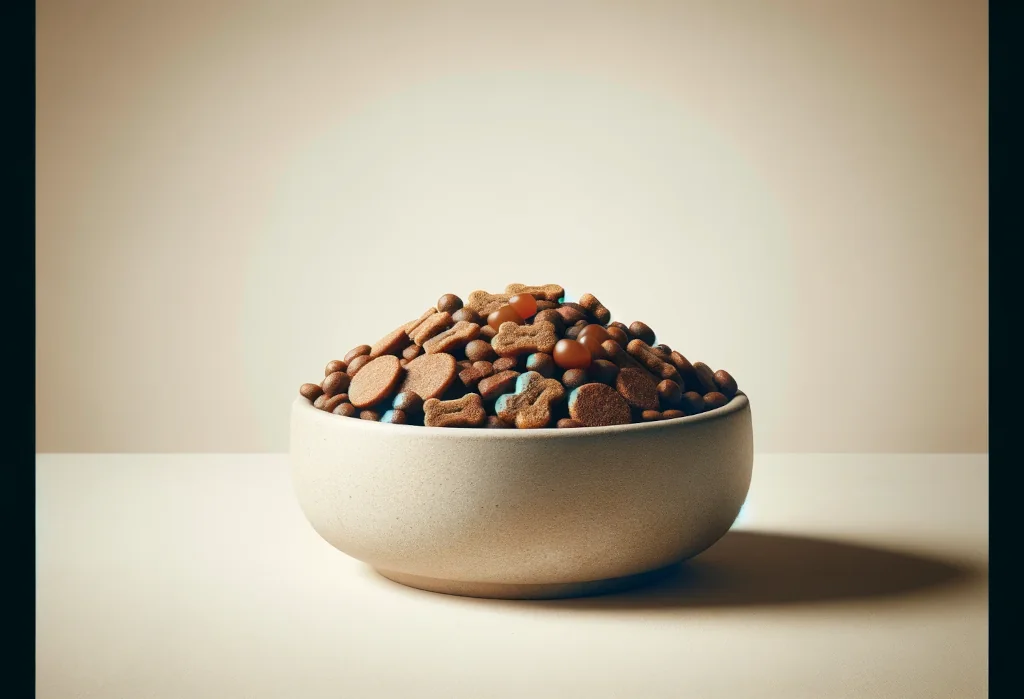When your fur baby starts needing insulin shots more than belly rubs, you know the dinner menu needs a do-over. Steering through the do’s and don’ts of a diabetic dog diet can feel like trying to teach an old dog new tricks—challenging but not impossible.
By the end of this post, you’ll have a clear roadmap on what to feed your diabetic champ to keep those tails wagging and those glucose levels in check.
Key takeaways:
- Opt for low-glycemic veggies like green beans and lean meats such as chicken to manage your diabetic dog’s glucose levels effectively.
- Maintain a strict feeding schedule, offering meals at the same times daily to help regulate insulin needs.
- Consult with your vet before making any changes to your dog’s diet to ensure it meets their specific health requirements.
What Foods Are Good for a Diabetic Dog?
When it comes to managing your furry friend’s diabetes, knowing what foods to feed them is pivotal. You’ll want to focus on foods that have a low glycemic index, as these will help regulate their blood sugar levels more effectively. Let’s break it down:
- Vegetables: Non-starchy options like green beans, broccoli, and carrots are fantastic. These veggies are not only low in sugar but also rich in fiber, which can aid in slow sugar absorption.
- Lean Meats: Chicken, turkey, and lean cuts of beef are excellent protein sources that won’t spike your dog’s glucose levels. Remember to cook them plainly, without any added fats or spices.
- Certain Grains: While grains are often looked at with a bit of skepticism in diabetic diets, not all grains are created equal. Barley and oats, for instance, have a lower glycemic index compared to white rice and can be included in moderation.
One specific, often overlooked option is pumpkin. It’s not just for fall; canned, unsweetened pumpkin is a fantastic source of fiber and has a low glycemic index, making it a perfect addition to a diabetic dog’s diet.
How Much and How Often Should You Feed Your Diabetic Dog?
Figuring out the right portion and timing for your dog’s meals is just as crucial as choosing the right foods. Here are some key points to keep in mind:
- Consistency is key: Aim to feed your dog at the same times every day. This helps regulate their body’s insulin needs.
- Controlled portion sizes: Work with your vet to determine the right amount of food your dog needs based on their size, activity level, and diabetes management needs. Overfeeding can lead to obesity, which is a no-go for diabetic dogs.
Remember, your dog’s metabolism and insulin requirements can provide clues on the best feeding schedule. Some dogs do well with two meals a day, while others might need their daily food portion divided into three or more meals.
Can Treats Still Be on the Menu for a Diabetic Dog?
TrAbsolutely, your diabetic dog doesn’t have to miss out on the joy of treats. The trick is to pick the right treats and consider them as part of the overall diet plan:
- Healthy homemade options: Think dehydrated meats (with no added salt or spices) or vegetables. A small piece of apple or a few blueberries can be good, just keep it minimal.
- Store-bought treats: Look for those specifically formulated for diabetic dogs. Ensure they are low in sugars and carbohydrates. Glycobalance is an example of a commercially available treat designed with diabetic dogs in mind.
Modifying the type and amount of treats is essential to avoid tipping the scales on your dog’s daily nutritional intake. Keeping a food diary can be helpful, allowing you to track what your dog eats each day, including those little extra nibbles. Always remember, when it comes to managing diabetes, every bite counts!
There is a link between ‘diet high in fibre and normal weight in companion dogs was found’, and those dogs that eat treats and kibble high in crude fibre are at a risk of obesity. Remember that crude fibre for healthy dogs shouldn’t go beyond 4%.
With these tailored nutritional strategies, you can play a significant role in managing your dog’s diabetes, ensuring they lead a happy, healthy life. The conversation doesn’t end here, though. Stay tuned for more insights into caring for a diabetic dog, including exercise tips and how to monitor their health efficiently.
What Ingredients Should You Avoid in Your Dog’s Diet?
When it comes to feeding a dog with diabetes, it’s not just about measuring the portions but also about knowing what to feed them. The wrong ingredients can cause their blood sugar to spike, complicating their condition. So, let’s dive into the no-go zone of ingredients to steer clear of:
-
High glycemic carbs : Foods like white rice, bread, and potatoes break down quickly, leading to a rapid increase in blood glucose levels. Opt for low-glycemic options like sweet potatoes and legumes, which offer a slower, more controlled release of energy.
-
Sugary treats : It might seem obvious, but it’s worth reiterating that sugary snacks are a big no-no. This doesn’t just mean the obvious culprits like candy, but also includes less obvious choices like certain commercially produced dog treats. Always check the label for hidden sugars!
-
High-fat content foods : While not directly affecting blood sugar levels, an excessive intake of fatty foods can lead to obesity, which complicates diabetes management.
Here’s a unique tip that often flies under the radar: Look out for foods with a high glycation end-products (AGEs) content. AGEs are formed when protein or fat combine with sugar in the bloodstream, and they can exacerbate diabetes complications. Foods cooked at high temperatures, including most commercially available pet foods, tend to have higher levels of AGEs. Opting for foods that are steamed or boiled might be a healthier choice for your diabetic dog.
When to Consult Your Vet About Your Dog’s Diet?
Remember, every dog is unique, and what works wonders for one might not suit another. That’s why it’s crucial to have a chat with your vet whenever you’re considering changes to your dog’s diet, especially if it’s as crucial as managing diabetes. Here’s when you should pick up the phone:
-
Any significant diet overhaul : Before you switch up your dog’s diet, it’s wise to consult your vet. They can provide recommendations tailored to your dog’s specific health condition.
-
Noticing any adverse reactions : If after a diet change, your dog shows signs of discomfort, lethargy, or any other out-of-the-ordinary symptoms, it’s time to consult the vet.
-
Regular check-ins : Managing diabetes is a dynamic process. Your dog’s needs can change over time, necessitating adjustments in their diet. Regular check-ups can help you stay one step ahead.
And here’s a golden nugget of advice that even seasoned dog owners might not be aware of: Collaborate with your vet to monitor your dog’s glucose levels at home. It’s a proactive step that can offer invaluable insights into how their diet affects their condition. Some vets might recommend a specific glucometer for pets or advise on how to use a human one correctly for your furry friend.
In feeding a dog with diabetes, knowledge is power. By understanding which ingredients to avoid and knowing when to seek professional advice, you’re setting your pup on a path to a healthier, happier life despite their condition. Remember, managing diabetes in dogs is a team effort between you, your furry friend, and your vet. So, keep those communication lines open, and let’s give our dogs the loving care they deserve!
Alex, a passionate animal lover, has experience in training and understanding animal behavior. As a proud pet parent to two dogs and three cats, he founded AnimalReport.net to share insights from animal experts and expand his knowledge of the animal kingdom.





